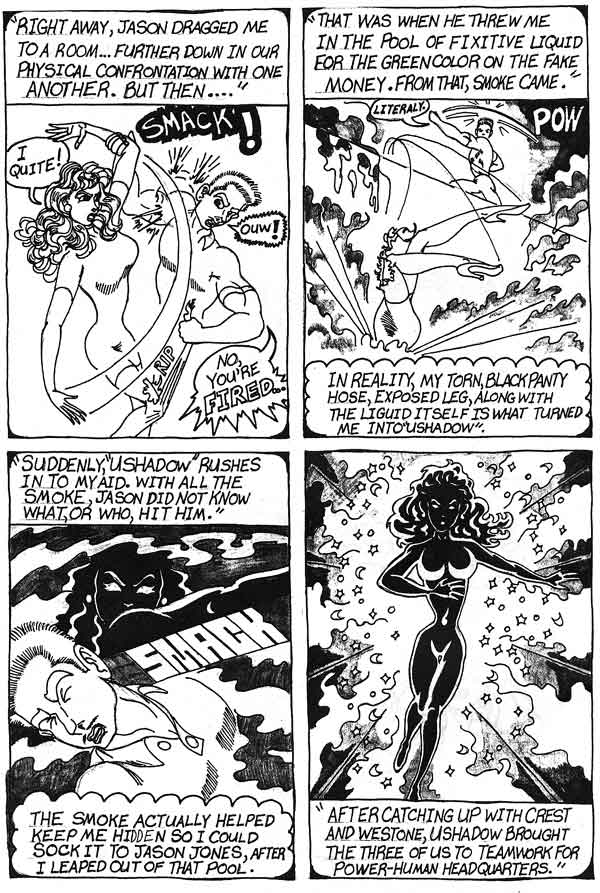All images by Emmanuel P. Gill, published by E-Lectric Comics, used with respect to the author
The comic that started it all a few years ago: WESTONE PAGE #1
The behavioral-engineering origin of the "Aura of Power"
The writing is fast-paced, very wordy, and, in general, bizarre. The stories mainly take place in a futuristic version of New York City and all but ignore anyone who isn't either a "Power Human" ("superhero" is a joint trademark of Marvel Comics and DC Comics) or in a Power Human's immediate biological family. The characters tend to give heavy exposition and call themselves and each other by full name, even in the middle of battles, which leads to dialogue like "JUST CALM DOWN PRICILLA ANN JONES...1) TELEPHONE IS PLANNING A FLIGHT WITH J.F.K. AIRPORT...2) REMIND PEOPLE WE'RE NOT RELATED HENCE YOUR SIR NAME." and my personal favorite, shown below:
To be fair, the superhuman characters in Chris Claremont's classic 1980s run on Uncanny X-Men often referred to each other by real names rather than 'superhero' names, and Claremont spent the first ten pages of each 22-page book giving exposition, both in dialogue and in narrative captions. Gill's version of this type of writing may be a bit more blunt than Claremont's, but he's working within a well-established and accepted format of comic writing.
Notably, every character who mentions his or her father has a problem with his or her father. Westone's father is an evil, scheming Power Human (for the first few issues, Westone is convinced that his father has murdered his mother) with a team of powered henchmen and a headquarters in Chicago called the "Empire Daddy Building."
There's also a glorious amount of gratuitous sexual content - mostly it's just making out, and no nudity is ever shown, but there's one particularly mindblowing panel that finds a way to show a two men and a woman having sex without any of their clothing removed (and with nothing 'naughty' showing).
By the way, that shiny/glowing lady with her hand down Westone's pants? She got her superpowers because her pantyhose was ripped when she fell into a vat of counterfeit-money dye after she QUITE her job.
This page introduces the new heroes "Open and Closed" and a fascinating subplot.
Emmanuel Gill can be looked at as an 'outsider artist' in that he is so clearly on the fringes of the comics world, but at the same time I wonder if he is as 'outside' as we may immediately assume. As bizarre as his comics are, they're working within an established genre and with the ultimate goal of being published and read by an audience, and I'm sure that he'd love for that audience to be as large as the fanbase for Marvel and DC Comics. Archtypal outsider artists such as Henry Darger and Francis Dec, from everything I can tell, worked without intentional recognition of an audience, or in cases like Dec, wanted an audience but had no interest in making "art." Comic books are different - they really only really function as comic books when they're published (even if by Xerox) and read by an audience. As such, Emmanuel Gill's body of work strikes me as "outsider" the same way that Genesis P-Orridge's does - it's bizarre and self-driven, but wants to be taken seriously in the long-running history of superhero comics.
Westone Page (on the motorcycle) and the rest of Teamwork For Power Humans
I don't mean it to sound like I'm making fun of Gill and his artistic output - I'm a fan, and I'm really impressed with his drive to produce and distribute his work to the best of his ability. He's clearly a hard worker (each issue features a colored-with-markers front cover and character bios, annotated and dated, on the back), his background influences obviously include many of the same superhero comics I loved most when I was growing up, and, well, I've been sitting on my thumbs planning a comic for years.
Emmanuel P. Gill's taken the plunge and DONE it, and for that, I salute him. I just hope that Hanley's has more issues available soon!
(coming up on this blog as soon as I can get copies of the reprints: Fletcher Hanks, the granddaddy of all outsider comic artists)













No comments:
Post a Comment